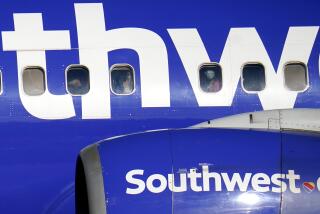They’d Rather Sneak Than Quit
- Share via
Airplane flights and smoking used to go together like first class and legroom, flight delays and complimentary booze.
But finding a place to smoke aloft in the late 1990s is becoming mission improbable as airline after airline announces that it has gone globally smoke-free.
The trend follows a 1992 resolution adopted by the International Civil Aviation Organization, urging a smoking ban on all international flights by July 1996. In the U.S., of course, smokers have had plenty of practice chewing their gum (and their nails). In 1988, Congress adopted a ban on smoking aboard domestic flights.
But even in today’s relatively smoke-free skies, some rule breakers still manage to squeeze in their nicotine fix. Never mind the $1,000 fine for smoking while the nonsmoking sign is on or smoking in a nonsmoking section, or the $2,000 fine for tampering with the lavatory smoke detector.
From 1987 to present, 1,203 passengers on U.S. flights have been charged with smoking while a no smoking sign was lit, according to statistics gathered by the Federal Aviation Administration; a fine was levied on 286, according to Roland Herwig, an FAA spokesman. (He could not determine whether smoking violations have increased since more airlines have gone smoke-free.)
An additional 1,283 were charged with smoking in the lavatory, with fines levied on 346. The statistics do not include violations in the “closed” category--among this group, cases where there were no fines.
Airline officials say that dealing with “smoke bandits” is a small but not insignificant problem, despite the hefty fines and vigilant crew, and that the number of violators has remained fairly constant over the last few years.
“The actual number of incidents is low,” says Jon Austin, spokesman for Northwest Airlines. “I would say we’re looking at a couple dozen people a year trying to beat the [lavatory] smoke detector and another couple dozen smoking in a nonsmoking section or on a nonsmoking flight.” The airline carries about 52 million passengers a year.
“On average, we interview five people per month, reminding them of the no-smoking policy,” says James Boyd, spokesman for Air New Zealand, which carries about 5.5 million passengers a year. The flights are smoke-free with the exception of flights to and from New Zealand and Japan and to and from New Zealand and South Korea, he says.
“Flight attendants are not going around sniffing people’s breath and going, ‘Aha!’ ” Austin notes. “But it’s pretty easy to detect if someone is smoking.”
Likewise, other airlines say flight attendants learn in their basic training to be on the lookout for smoke bandits.
So how do the dyed-in-the-wool smokers attempt to outwit the system?
The most popular approach is to figure out a way to outwit the lavatory smoke detector. Shower caps are a popular choice for covering up the detector’s sensor, Austin says. Or, passengers place toilet tissue or their hands over the detector. Some try to remove the battery.
But not all smoke detectors are created equal, and many airlines are installing more foolproof models. “Some of our newer ones are hard-wired,” Austin says.
Smoke detectors on Boeing aircraft require special tools to disassemble, says Mary Jean Olsen, spokeswoman for Boeing Commercial Airplane Group in Seattle. “They are flush-mounted to the lavatory ceiling and hard-wired. There is not a battery that can be removed.”
And how serious are the airlines about enforcement?
“If a passenger is caught smoking, a pilot might radio the ground and say, ‘We have a violation,’ ” says one airline official. When the plane lands, the passenger would be turned over to authorities.
Sometimes passengers are unaware that they have violated a rule, says Boyd of Air New Zealand, and quickly agree to snuff out their smoke.
And not everyone, it seems, wants to make life miserable for flying smokers.
In a buck-the-trend move, Air France late last year launched an amenity they say is found on no other airline: the stand-up smoker’s bar. These bar areas--one for economy class and one for business and first class passengers--are fully enclosed by drapes and ventilated by special smoke-extracting fans, says spokesman Bruce Haxthausen.
The bars, found on all of the line’s Boeing 747-400 models as well as the Airbus A340 and Boeing 767, but not on flights in or out of Miami and Chicago, close down only during meal service.
And an Ohio man who smokes a pack and a half a day is also trying to help out his fellow tobacco lovers.
“Smoking is a personal right issue,” says Michael Banks, 45, who maintains a Web site to alert fellow smokers to airlines and flights on which smoking is still permitted.
“I had 2,000 visitors in the past year,” says Banks, a journalist-turned-book-author who updates his Web page information every two or three weeks, obtaining information directly from the airlines and his 80 regular Web site visitors.
The address is https://w3.one.net/(TILDE)banks/smoking.htm.
More to Read
Sign up for The Wild
We’ll help you find the best places to hike, bike and run, as well as the perfect silent spots for meditation and yoga.
You may occasionally receive promotional content from the Los Angeles Times.






